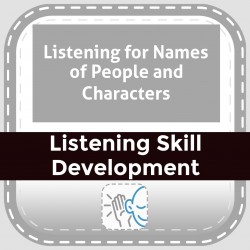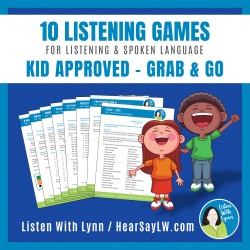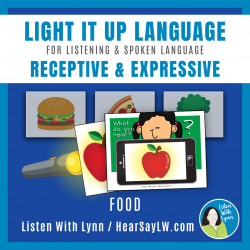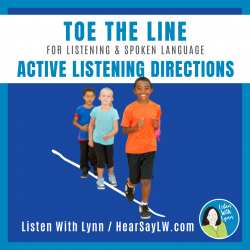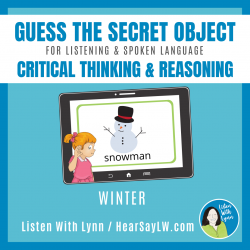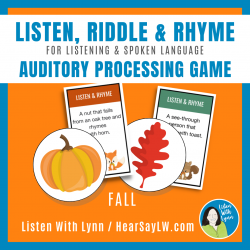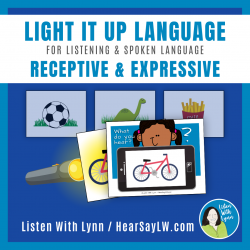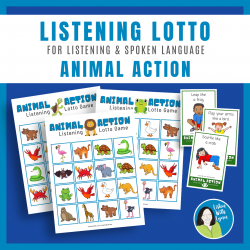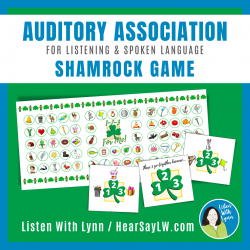Ability Levels
Categories
Resource Types
Age/Grade Range
CCSS
Anchor Standard
Speaking & Listening
Language
Reading
Critical Thinking For Listening and Language Winter Snowpals
$ 5
Kids love playing “WHAT’S MISSING?” games as they learn to think critically, develop listening, and memory skills while building receptive and expressive language.The Stand-Up Snowpal resource include
...
urce includes SEVEN interactive activities for preschoolers through elementary children. Stress-free ways for practicing and building communication skills with the kids you see at school or for therapy. FUN for the kids and SIMPLE for you! Quick and easy one-time print and cut the Snowpals.Use all winter and year after year.TARGETS:Kids use their existing knowledge, experiences, and problem-solving skills for✤ Critical thinking✤ Communication✤ Auditory and visual memory✤ Compare and contrast✤ Part to whole relationships✤ Cause and effect✤ ObservationsINCLUDES:Seven activities or ways to playDeck of sixteen Snowpal cardsEight colorful stand-up SnowpalsInstruction guideListening and Spoken Language TipsYou’ll need 8 papers cups◈ ◈ ◈ ◈ ◈ ◈ ◈ ◈ ◈ ◈ ◈ ◈ ◈ ◈ ◈ ◈ ◈ ◈ ◈ ◈ ◈ ◈ ◈ ◈ ◈ ◈ ◈ ◈ ◈ ◈ CUSTOMER TIPS:➼ Questions? Email me before purchasing this resource or anytime later.➼ Follow me to be updated with newbies and freebies!♥ Sign-up HERE for the Listen With Lynn Newsletter♥ Let’s Connect:InstagramFacebookKeep up your good work. I am blessed to help along the way. Thanks so much!Lynn
Listening for Names of People and Characters
$ 195
Prompts (excerpts from classic children's stories and school-based role play scenarios) to practice identifying spoken names in sentences and discourse. Includes information for teacher about why lear
...
ning and remembering names can be challenging for DHH students, sample data collection table and suggestions for extension activities.
10 Kid Approved Games Grinning From Ear To Ear
$ 6
TEN Kid-approved listening games and language activities for your grab-and-go toolbox. Each game includes specific goals to target such as following directions, auditory memory, processing, and compre
...
rehension while building language and communication. I have used these games with children for countless years. Expect lots of giggles and grins.Ideal for: Teletherapy, Speech, Listening and Spoken Language, Distance Learning, Classroom, No PrintWhat's included:A 21-page resource with:✧ 10 Ready to Go Games - No-Prep or very little preparation✧ Detailed Gameplay suggestions✧ Answers to each prompt when appropriate✧ A helpful guide and instructions✧ Listening and Spoken Language (LSL) Tips✧ Terms of Use10 GAMES AND GOAL AREAS1. Woot Woot! Booooo! targets listening, auditory processing and comprehension of connected speech at the sentence level.2. I’m Going On A ________ targets listening, auditory memory and recalling details in sequence.3. Bean Bag Boogie targets listening, multi-step directions, auditory processing and comprehension.4. Simon Says Or Not targets listening, auditory processing, following multi-step directions and instructions.5. Thumbs Up. Thumbs Down targets listening, auditory processing and comprehension of connected speech at the sentence level.6. I Say - Go targets listening, temporal auditory memory skills, auditory processing and following multi-step directions.7. Found Sounds Outdoor Scavenger Hunt targets listening, identifying and localizing common outdoor sounds and their descriptors.8. Ear To Ear - Back To Back targets listening, auditory processing, following and giving directions, joint attention, two-way communication skills and cooperation.9. Do What You Hear Not What You See targets listening, following complex directions and auditory processing with distractions.10. Draw A Rhyme targets listening, following directions, auditory closure, phonemic awareness, recognizing and generating rhyming words.
FOOD Auditory Processing Receptive & Expressive Language
$ 5
You'll love the FOOD version of Light It Up Language! Kids listen to clues to identify 16 hidden FOOD vocabulary pictures. Each of the pictures has four clues that are increasingly more specific.The m
...
magic happens by lighting up the “What Do You Hear?” cards. Hidden pictures are held up to a flashlight and the FOOD images amazingly appear. How fun! Once the hidden picture is revealed the child recalls and uses the clues to describe the FOOD. Thereby stretching their auditory memory, descriptive language, and expressive language skills.TARGETS: RECEPTIVE: This game builds critical thinking and reasoning skills by categorizing, making inferences, and drawing conclusions. EXPRESSIVE: The child recalls and uses clues to describe the hidden object. INCLUDES:✧ Listening & language guide with instructions✧ Target or goal suggestions✧ 8 What Do You Hear? cards (printed twice)✧ 16 Hidden FOOD Picture Vocabulary Cards✧ 64 Prompt Clues - 16 objects with four details each that get increasingly more specific✧ A Script with scaffolding strategies✧ Listening and Spoken Language Tips ➼ EASY one-time quick game prep and you're all set to use year after year. ➼ You’ll need a FLASHLIGHT, a lamp, or a sunny window.◈ ◈ ◈ ◈ ◈ ◈ ◈ ◈ ◈ ◈ ◈ ◈ ◈ ◈ ◈ ◈ ◈ ◈ ◈ ◈ ◈ CUSTOMER TIPS:➼ Questions? Please email me before purchasing this resource or anytime later.♥ Sign-up HERE for the Listen With Lynn emails♥ For more ideas visit my blog: HearSayLW.comSTAY CONNECTED:✧ Sign-up here for the Listen With Lynn emails✧ Follow on Facebook - Lynn A. Wood - LSL Auditory Verbal Therapist and Rehab Audiologist✧ Follow on Instagram @auditoryverbal_listenwithlynn❤ Keep up your excellent work. I am blessed to help along the way. Thanks so much!Lynn Wood
Listening Directions Action Packed Toe The Line Game
$ 3
Listen, Learn, Move and Toe The Line!TOE THE LINE is an action-packed listening activity that targets basic concepts, verbs, and following one or multi-step directions and is full of giggles and wiggl
...
wiggles. It is well-loved by preschool and school-aged kids and can be easily leveled up or down to meet their goals.Ideal for: Parents, Audiologists, Speech Therapists, Auditory Verbal Therapist, Teachers of the Deaf and Hard of Hearing, Listening and Spoken Language, Early Intervention, Teletherapy, Distance LearningNo Prep! Grab a roll of colored or masking tape, make some space to target:✧ Action verbs✧ Basic concepts✧ Five different types of verbal directions➼ One, Two, and Multi-Step Directions➼ Sequential Directions involve following directions in a specific order.➼ Temporal Directions target the ability to follow directions containing the words “before”, “after” and “while” or “at the same time”.➼ Conditional Directions involve listening and deciding what actions to do based on the given condition(s).What's included:✤ The resource can be used as a parent handout or when coaching families✤ Suggested action verbs, concepts, and directions✤ Data monitoring and collection sheet✤ Listening and Spoken Language tips
WINTER GUESS THE SECRET OBJECT Auditory memory, Comprehension Inferences Vocabulary
$ 7
WINTER - Guess the Secret Object targets auditory memory, comprehension, and processing skills. Kids love to make guesses while building their listening, critical thinking, reasoning skills, and winte
...
inter vocabulary. For each secret object, the child is categorizing and analyzing information, making inferences, and drawing conclusions.Ideal for: Listening and Spoken Language, Deaf & Hard of Hearing, Speech, ELA, Teletherapy, Distance Learning, Digital - Digital and PrintThe goal is to make logical guesses and identify all 15 secret objects by listening to the four clues presented one by one through hearing alone. Each of the clues is read aloud by the adult. The clues get increasingly more specific. The game fosters two-way conversation and critical thinking skills.A cue to listen slide is included between each Secret Object. The child listens and the adult reads the clues. Talking about an object before showing it provides ear contact before eye contact, which is critical to growing a child’s brain for auditory skills.Once the secret object is revealed the next activity is for the child to remember and use each of the clues to clearly describe the object in connected speech. Thereby stretching their auditory memory, building vocabulary, and descriptive language skills.★ This is a WINTER version of a best selling larger resource - Guess the Secret Object★★The vocabulary in this resource is the same that is found in Listen For Inferences of the WINTER Listen Search & Find game.What's included:44-page resourceDigital Version: The game can be played on a computer, iPad, or teletherapy platforms using PDF reader apps. Print Version: This resource includes printable game cards. Fold the game cards in half with the Secret Object on one side and the clues on the other side.A Script with scaffolding strategies to help children recall details and put them all together for comprehension.Handout with the Clues for the 15 Secret Objects.Listening and Spoken Language TipsTerms of UsePlease note: Guess My Secret Object is a serve and return conversational game between the adult and the listener. I have been asked if the game includes an audio component that would allow the child to play independently. There are no sound bytes included.A Versatile resource that checks ✅ all the boxes.✅ Targets Multiple Listening and Spoken Language GoalsNo Print Version✅ Distance Learning✅ Teletherapy✅ Face to face✅ Family fun game at homePrint Version✅ Individual therapy sessions✅ School-based lessons✅ Small and mixed groups✅ Family fun◈ ◈ ◈ ◈ ◈ ◈ ◈ ◈ ◈ ◈ ◈ ◈ ◈ ◈ ◈ ◈ ◈ ◈ ◈ ◈ ◈ ◈ ◈ ◈ ◈ ◈ ◈ ◈ ◈ ◈ ◈ ◈ ◈ ◈CUSTOMER TIPS:➼ Questions? Feel free to email me before purchasing this resource or anytime later.➼ Sign-up HERE for the Listen With Lynn NewsletterLet’s Connect:InstagramFacebookPinterestHearSayLW.comHearSayLW BlogTwitter
AUTUMN Auditory Processing and Vocabulary Listen Riddle & Rhyme
$ 6
This resource builds on the excitement of AUTUMN while players develop auditory processing skills, solve riddles with rhyming or sound-alike clues, and learn autumn vocabulary while playing a competit
...
petitive game.IDEAL FOR: Deaf & Hard of Hearing, Listening & Spoken Language,Auditory Verbal Sessions, Speech Therapy, Special Education,ELA, Teletherapy, Home LearningYOU CAN TARGET:• Auditory processing, closure, memory, and comprehension• Categories, rhyming, inferences, critical thinking• Autumn vocabulary and background knowledgeWHAT'S INCLUDED:32 Autumn-related rhyming riddles game cardsAn engaging and colorful companion game with Fall objectsList of the rhyming riddle promptsListening & Spoken Language (LSL) TipsA helpful guide and instructions◈ ◈ ◈ ◈ ◈ ◈CUSTOMER TIPS:➯ Questions? Feel free to email me before purchasing this resource or anytime later. ◈ ◈ ◈◈ ◈ ◈LET'S CONNECT:Sign up HERE for the Listen With Lynn emailsInstagramFacebookKeep up your good work. I am blessed to help along the way. Thanks so much!Lynn Wood
LIGHT IT UP LANGUAGE - RECEPTIVE AND EXPRESSIVE ACTIVITY
$ 5
Kids love Light It Up Language!
Kids listen to clues to identify 20 hidden pictures. The magic happens by lighting up the “What Do You Hear?” cards. The cards are held up to sunlight or a flashl
...
lashlight and the picture magically appears on the screen from behind. The trick is that a hidden picture is glued behind a blank tablet screen. This is an engaging activity that targets auditory memory, comprehension, processing, and receptive and expressive language skills. RECEPTIVE: This game builds critical thinking and reasoning skills by categorizing, making inferences, and drawing conclusions. EXPRESSIVE: Once the hidden picture is revealed the child recalls and uses the clues to describe the object. Thereby, stretching their auditory memory, descriptive language, and expressive language skills. IDEAL FOR: Listening & Spoken Language, Deaf & Hard of Hearing, Speech and Language Therapy, School Lessons, Auditory Verbal Sessions, PreK-K and Primary Teachers, SPED Teachers, ELL Teachers, ESL/EFL Teachers, Homeschoolers, Teletherapists INCLUDES:✧ Listening & language guide with instructions✧ Target or goal suggestions✧ 20 What do you hear? cards✧ 20 Hidden object picture cards✧ 60 Prompt Clues - 20 objects with three details each that get increasingly more specific✧ A Script with scaffolding strategies✧ Listening and Spoken Language Tips EASY ONE TIME GAME PREP Print and cut out the What do you hear? cardsPrint and cut out the hidden object cardsGlue one secret object card behind each What do you hear? card.You’ll need a flashlight, a lamp or a sunny window. COMPANION RESOURCESYou'll love all these resources created for kids with hearing loss!
SELF-ADVOCACY GAMES AND ACTIVITIESLISTEN BY THE MONTH CALENDARSTAKE A U-TURN FLEXIBLE LANGUAGE GAMESLISTENING AND LANGUAGE GAMESFREE - 12 MONTHS OF RIDDLES & JOKES◈ ◈ ◈ ◈ ◈ ◈ ◈ ◈ ◈ ◈ ◈ ◈ ◈ ◈ ◈ ◈ ◈ ◈CUSTOMER TIPS:➼ Questions? Email me before purchasing this resource or anytime later.♥ Sign-up HERE for the Listen With Lynn Newsletter♥ For more ideas visit my blog: HearSayLW.comLet’s Connect:InstagramFacebookPinterestHearSayLW.comHearSayLW BlogTwitterKeep up your good work. I am blessed to help along the way. Thanks so much!Lynn
Animal Action Listening Lotto - Listening and Language Game
$ 5
Who doesn't love playing Lotto games? Animal Action Listening Lotto is an active following directions game that gets kids listening, moving, thinking, and learning. It is action-packed fun for childre
...
n with hearing loss, auditory processing needs, and kids who can benefit from practicing listening skills. Kids expand their spoken language and increase their auditory working memory and processing skills while engaged and active.YOU CAN TARGET: The Lotto game can help children:follow auditory directionsrecall and process directionslearn to 'chunk' auditory informationexpand vocabulary for action verbs (slither, waddle, arch, balance...)learn to make comparisons with similes (Arch your back like a cat.)ask for clarification if they have trouble remembering or mishear
WHAT’S INCLUDED?20 Animal Action Listening Lotto game boards20 Calling Cards with sound images3 Game Extension IdeasListening and Spoken Language Tips FACE TO FACE - TELETHERAPY - HOME
✢ PRINT - One-time easy prep and use time and time again✢ DIGITAL - The digital matrices can be opened and played with your favorite PDF reader app on a tablet or iPad. Tokens can be placed directly on the screen.on a computer. Open the PDF game board with the 36 spring egg images and use a PDF reader such as Adobe Acrobat Reader DC which is free. The listener used the annotation tools to mark the cards like Lotto.◈ ◈ ◈ ◈ ◈ ◈ ◈ ◈ ◈ ◈ ◈ ◈ ◈ ◈ ◈ ◈ ◈ ◈ ◈ ◈ ◈ ◈ ◈ ◈ ◈ ◈ ◈ ◈ ◈ STAY CONNECTED:✧ Follow on Facebook - Lynn A. Wood - LSL Auditory Verbal Therapist and Rehab Audiologist✧ Follow on Instagram @auditoryverbal_listenwithlynn✧ Sign-up HERE for the Listen With Lynn Newsletter✧ Feel free to email me with questions, before purchasing this resource or anytime later. ❤ Keep up your good work. I am blessed to help along the way. Thanks so much! Lynn
Category and Auditory Association SHAMROCK – Three For Me Game
$ 6
Three For Me is a competitive St. Patrick's Day listening and language game that is fun to play the entire month of March. It targets vocabulary, categories, and associations. Players scan the game b
...
ame board featuring 69 bright and engaging objects to find three objects with something in common ( like a shamrock). They shout out, “Three For Me!”. They mark the three items and tell why they go together. The combinations on the gameboard are countless!TARGETS: Listening and spoken language, auditory associations and comprehension, vocabulary, descriptive language, categories, and higher-level critical thinking.WHAT'S INCLUDED:A zipped file that contains:✤ 1 2 3 For Me gameboard including a Print version, a Digital version, and a Powerpoint™ gameboard with moveable playing pieces✤ Shamrock Go Together Prompt cards✤Nearly 20 Go-Together example answers to make the therapist or teacher's job a breeze.✤ A guide with instructions for parents, teachers, and therapists with information for growing listening and spoken language✤ Listening & Spoken Language (LSL) Tips ✤✤ DIGITAL, PRINTABLE and POWERPOINT GAME BOARDS ✤✤1-2-3 For Me can be - ✧ Printed to play in face-to-face sessions.✧ Played using the interactive PDF on a computer, iPad, or teletherapy platforms using PDF reader apps such as the free Adobe Reader DC. In teletherapy, open the PDF, then screen share that window into the teletherapy platform. Use free annotation tools to play.✧ Played with the PowerPoint game board with moveable pieces◈ ◈ ◈ ◈ ◈ ◈ ◈ ◈ ◈ ◈ ◈ ◈ ◈ ◈ ◈ ◈ ◈ ◈ ◈ ◈ ◈ ◈ ◈ ◈ ◈ ◈ ◈ ◈ ◈ ◈ CUSTOMER TIPS:➼ Questions? Email me before purchasing this resource or anytime later.♥ Sign-up HERE for the Listen With Lynn EmailsLet’s Connect:InstagramFacebookKeep up your good work. I am blessed to help along the way. Thanks so much!Lynn
 Your browser is out of date. For best experience switch to latest updated Browser.
Your browser is out of date. For best experience switch to latest updated Browser.
 Get Chrome
Get Chrome Get Edge
Get Edge Get Firefox
Get Firefox
